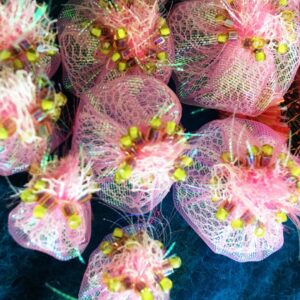I know you all know by now I host a Podcast called Stitch Safari.
But do you know just how much subtle influence all that research into the show is having on my work?
Apart from the fact that I actually read books now – as opposed to just looking at all the pretty pictures, I’m also actively looking to incorporate some of the techniques I’ve researched, into my new work.
What techniques exactly? Well, let me see…
- employing embroidered slips – this technique was known from Medieval times and well used in Elizabethan times too. It simply means working small embroidered areas and then applying them to the main piece. This could be used because the main ground fabric was difficult to work on but also meant that a number of people could be employed to work on a repetitive design motif, at the same time – saving both time and money.

- my embroidered slips were worked onto felt, then trimmed. I’ll simply apply them to the main fabric and cover the exposed white felt with either embroidery or other dimensional elements. Why did I work this way? Because I know the dimension I’ll create for this work will make embroidering directly onto the fabric problematic. This way I can alleviate that.
- there’s mention of ‘puffs’ dating back to the 16th century, with the practice of making puffs from circles of gathered fabric well in place by the Victorian era. Like many patchwork practices, it was also a means of reusing and repurposing fabric scraps into decorative and useful items. In America they’re more often referred to as yo-yo’s, however, the British tend to call them Suffolk Puffs because there was a supposed link with them having been stuffed with Suffolk wool.

- my Suffolk Puffs are made with two layers of fabric – one a pretty, glitzy pink and the other a simple yet quite stiff white tulle. I didn’t hem the edges of the circles, simply gathered them, enabling the frayed edges to congregate together in the centre. Plus the tulle made the puffs really puff.
- Creating and using beads dates back to 10,000 BC with the find of ostrich shell beads in Africa, carbon-dated to that time. The ancient Egyptians made beads molded around a stick or straw with many ancient cultures making them from locally sourced materials.
- Coins were often attached to the wearer’s garments in nomadic cultures as a means of keeping their wealth close by and safe. The word sequin comes from the Arabic word ‘sikka’ meaning coin, later becoming the Venetian word zecchino in the late 16th century, then the French word, sequin, which we know today. The discovery of Tutankhamen’s tomb revealed splendid garments adorned with tiny discs made of pure gold. It wasn’t until the 1930’s that a process was developed to make lightweight sequins using gelatin covered with lead paint. These however melted easily and dissolved in water. Herbert Lieberman then developed acetate sequins while working with Eastman Kodak. Mylar and plastics now make up modern sequins.

- Honestly, I have to say I love working with beads and sequins – there’s something so meditative about the repetitive application of each one – and the results are always worth the effort.
- The term stumpwork refers to a form of dimensional embroidery also called Raised or Embossed work. The technique requires working stitches around a wire to create individual forms to make leaves, insect wings, or flower petals which are then attached to the ground fabric, securely stitching the wires to the back. Padding out stitches is also used in stumpwork or raised work.

- Surprise, surprise – I’ve never attempted this technique before and I’ve discovered I love it. It’s not as difficult as it looks and the result is a malleable, form. I found two of Jane Nicholas’s books to be extremely helpful, as well as a few YouTube videos. Sometimes just jumping in and giving something a go, pays dividends.
So a passionate interest in embroidery and history has led to research for a podcast – with the offshoot that I’m more adventurous in my use of technique. Who knew?


